PINK CONNE ION

Suchitra Ella on ‘Made in India’ Covaxin Vol 10 Issue 2: Nov ‘23 - Jan ‘24
Uthara Babu
Not allowing cancer to define her



Suchitra Ella on ‘Made in India’ Covaxin Vol 10 Issue 2: Nov ‘23 - Jan ‘24
Uthara Babu
Not allowing cancer to define her

TThe Covid years were trying to say the least, even if all of it has become a dim memory.
It was heartbreaking that we couldn’t visit friends or relatives, or allow anyone to visit us during that period. Isolated within our homes, we learnt to be with ourselves, without too many distractions to keep us entertained. We did watch television, but tired of that too and turned to reading and keeping journals. Probably, some learnt the value of silence and prayer.
While all of us were steering the pandemic in our own ways, losing friends and family in the process sometimes, there were those brave soldiers – the doctors, nurses, and scientists working around-the-clock to get us out of the pandemic. We felt shivers down our spine literally when Suchitra Ella, whose Bharat Biotech created the first Indian made vaccine, told us how the live strain of Covid virus had to be brought back from Pune. And, how the team worked on this to develop a vaccine.
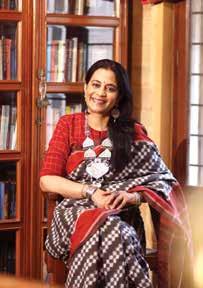
Suchitra, her husband Dr Krishna and their team, who spent nine harrowing months racing against time to develop the life-saving vaccine, somehow found faith and strength to keep going.
We are in awe of people like them; of the many PPE-clad doctors who tended to Covid patients; the paramedic staff who couldn’t even hug their children for fear of infecting them. We at Pink are proud of our exclusive interview with Suchitra Ella. And, thankful to Dr Raghu Ram for enabling it.
Truly, we do hope the lessons learnt during Covid stay with us.
Ratna Rao Shekar
CANCER CONQUEROR
Historophile Uthara Babu discovered she had stage 4 ovarian cancer in February this year. The 27-year-old shares her story on why and how she decided to fight her diagnosis
MAKING A DIFFERENCE
In an exclusive and rare interview, Suchitra Ella, co-founder and MD of Bharat Biotech, talks about the challenges and hard work that went into producing the life-saving and affordable Made in India vaccine – Covaxin®
HERITAGE
The stunning Chettinad mansions, situated in a secluded corner of Tamil Nadu, stand testimony of a rich bygone era. Pink tours these homes, as part of the Chettinad Heritage and Cultural Festival
MY VIEW
In his quarterly column, Dr Raghu Ram explains in detail what one needs to know about breast cancer before visiting the doctor. Arm yourself with this checklist
UBF DIARY
A round up of key activities and events at UBF in the last quarter

EDITOR
Ratna Rao Shekar
CONTRIBUTORS
Minal Khona
Mallik Thatipalli
Nivedita Choudhuri
DESIGN
Malvika Mehra
COPY EDITOR
Kavitha Shanmugam
PUBLISHED BY Ushalakshmi Breast Cancer Foundation
PRINTED AT
Pragati Offset Pvt Ltd., 17, Red Hills, Hyderabad - 500 004
KIMS-USHALAKSHMI
Centre for Breast Diseases
Krishna Institute of Medical Sciences, Minister Road, Secunderabad - 500 003
+91-91009 13217
ubfhyderabad@gmail.com
www.breastcancerindia.org
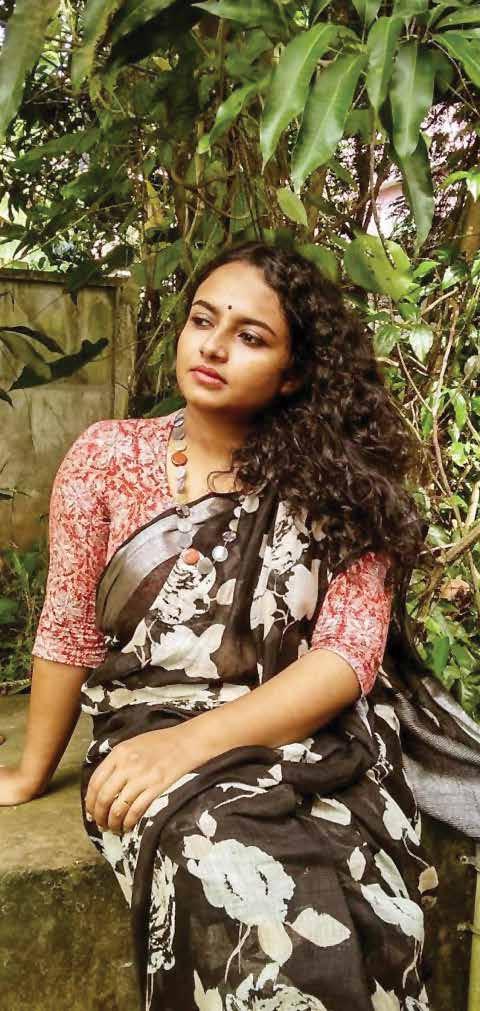
Life was sailing smoothly for 27-year-old historophile Uthara Babu until eight months ago when she discovered she had stage 4 ovarian cancer. However, she decided to fight against her fate, intent on fulfilling her dream to complete her PhD and become an archaeologist.
Nivedita Choudhuri talks to this intrepid cancer survivor
Cancer does not define Uthara Babu. What truly defines her is her love for history, dance, and family (not necessarily in that order). Life was going great for the 27-year-old historophile – she was in the third year of her PhD degree in archaeology, and she was married to the love of her life. However, she was in for a rude shock, when her symptoms of abdominal pain and fatigue turned out to be something as devastating and crushing as cancer.
The Thrissur native and student at the Central University of Tamil Nadu at Thiruvarur admits to being an average student till she became smitten with history. There was no looking back after that as she coasted through an integrated five-year course (BA and MA) in history at Pondicherry University and then an MPhil. She taught briefly before enrolling for a PhD to study early historic settlements in Ernakulam district’s Pattanam village.
Uthara’s second passion – dance – also took centre stage in her life from a young age. “My father, Babu Kariat, a retired deputy director of Kerala Institute of Local Administration, and librarian mother Dr Meera K encouraged me to spread my wings and fly. I trained in four classical dance forms – Mohiniattam, Bharatnatyam, Kathakali and Kuchipudi before focusing solely on Bharatnatyam,” Uthara says in a chat with Pink
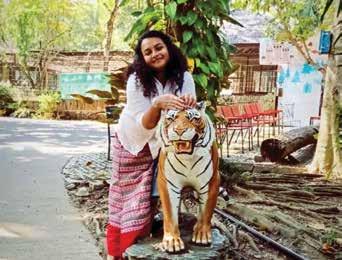
Uthara decided to fight against her fate and finish her treatment quickly
Uthara took part in state government competitions, and she performed for Doordarshan as well as being part of two documentaries. She skilfully balanced her academics with dance because she never felt happier than when she was dancing.
Meanwhile, the fieldwork, excavations and conferences sometimes left Uthara tired. She suffered from Polycystic Ovary Syndrome (PCOS) and endometriosis, but doctors told her that immediate action was not required though a scan had revealed a mass in her uterus. By November 2022, Uthara found it difficult to finish the food on her plate. Along with that, she began experiencing cramps in her lower abdomen, back pain, and had bloating. She put it down to the scooter rides she had to take on field trips.
In January 2023, she had to attend a conference in IIT, Bombay. “I was experiencing terrible fatigue and, instead of boarding a plane, I decided to have a blood test,” she recounts.
The ESR level was found to be very high. A doctor told her to eat healthily and increase her intake of nutritious supplements like dates and raisins. But, she had to be admitted to hospital as her abdominal pain increased. A gynaecologist suggested that she get her CA-125 test done.
This is a type of tumour marker and high levels of CA-125 may be found in people who have ovarian cancer, she explains, adding that her reading came back from the lab as 230, which was way above the normal range.
“An MRI scan, biopsy from the ovary, endoscopy and PET scan followed. I got the damning verdict on February 4, 2023 –ironically, on World Cancer Day. I was told that I had stage 4 ovarian cancer. I felt surreal when the results were disclosed. There were so many questions in my mind. The foremost was whether I would survive. Getting ovarian cancer at 27 is very, very rare,” she says.
Her world, until then, had revolved around archaeology, research, excavations, and peer-reviewed articles. “This was certainly not part of the plan,” Uthara points out ruefully.
“I went home in a daze. It was as if my world had collapsed. But, my parents, sister Priyamvada and husband Harikrishnan rallied around quickly. They said we are in this together. My in-laws were also supportive,” she adds.
A hysterectomy (surgical removal of uterus) and oophorectomy (surgical removal of ovaries) followed. She was asked to have six rounds of chemotherapy in two blocks of three rounds each. The disease had spread to her stomach and part of the stomach had to be removed as well, explains Uthara.
I got the damning verdict on February 4, 2023 – ironically, on World Cancer Day. I was told that I had stage 4 ovarian cancer. I felt surreal when the results were disclosed. There were so many questions in my mind. The foremost was whether I would survive. Getting ovarian cancer at 27 is very, very rare
Uthara found hidden depths of strength within her. “I decided to fight against my fate and finish my treatment quickly. I wanted to finish my PhD and become an archaeologist. I wanted to study past human life, artefacts, and human activities. I wanted to dwell on ancient, prehistoric, and extinct cultures. Not on carcinogens, chemotherapy, scans, and blood tests. I was very strong emotionally after the initial shock,” she recalls.
She took the hair loss in her stride as well, choosing to cover her head with a multitude of colourful scarves. But there was more she had to cope with.
“I also had to deal with menopause, which happened following the hysterectomy, oophorectomy, and chemotherapy. Menopause – which happens to women between the ages of 45 and 55 – happened to me at 27,” she says.
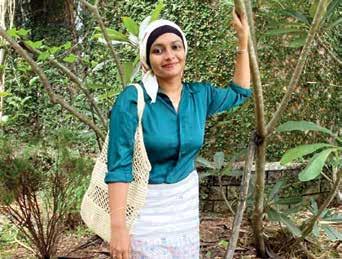
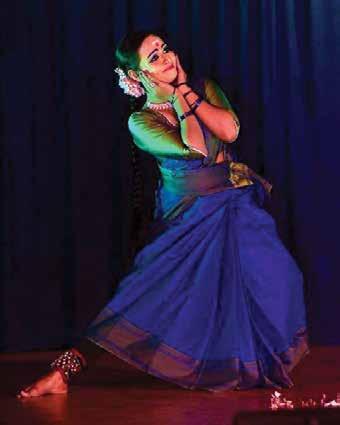
Hot flashes, night sweats and mood swings became a regular feature in her life. Not wanting to let these symptoms impact her life, she started reading medical papers and case studies to get answers and find some kind of relief for her symptoms.
“I had long discussions with my cousin sister, who is a pathologist, and took her advice, ” says Uthara.
She also connected to people living abroad and to ovarian cancer communities. Uthara shares, “I found I could talk openly and honestly about how I was feeling when I connected with these groups. These groups are a godsend, and I found comfort and understanding from people living with ovarian cancer. I could interact as much or as little as I wanted to with people who supported me and understood what I was going through. I kept myself updated on medicines and treatment worldwide.”
Cancer counselling was suggested to her to sort out any problems she was having while facing cancer. Counselling does help patients to cope with their reactions to the illness, relationships, and personal issues. However, she wanted to manage her issues on her own.
Uthara remembers the side effects she had to undergo. “Other than hair loss, I had difficulty walking after chemotherapy. I could not sit on the floor, lift heavy things, bend and do work after the surgery. My haemoglobin was low. To keep my mind fresh, I started practising simple yoga moves. I could not dance like before but I developed a new passion – cooking,” she says.
She also started following a Mediterranean diet, which has been found to improve the efficacy of cancer treatments. She had to take medical leave, but she decided to read research papers and keep abreast with her dissertation.
“I read books and interacted with experts all over the world. I was blessed to find unstinting support from the international academic community. A professor in Australia sent books for me to read,” Uthara reminisces.
Even in the midst of fighting cancer, Uthara is excited about an upcoming trip to Egypt in January next year. She will have the chance to visit Berenice Troglodytica, also known as Berenike, an ancient seaport on the shore of the Red Sea, for an excavation project.
I also had to deal with menopause, which happened following the hysterectomy, oophorectomy, and chemotherapy. Menopause – which happens to women between the ages of 45 and 55 – happened to me at 27
She is upbeat and hopes to make it to Egypt, which she terms “a historophile’s delight”. “I could not have made it this far without the support of my family members. I have always been able to talk to my parents about anything under the sun. I found I could talk easily to my parents on death and this disease. The reason I don’t feel scared is because of the conversations I have had with them. My father is emphatic that there is nothing to fear. My mother has a wonderful sense of humour. She’ll crack jokes about my head scarves. She would also say that my ancestors are there on the soil where I work. They would look after me,” shares Uthara.
Uthara is thankful to her doctors too, who were very patient and ready to clear her doubts or explain a line of treatment.
There are some new realities Uthara must get used to, such as not being able to have children. Freezing her eggs was not an option either. Other things in her life remain the same though. There is her beloved dance and research that she will return to shortly.
In the meantime, she is currently taking out time for herself. Before her diagnosis, Uthara was always on the move. She had an extremely busy schedule as any woman in her twenties. Now, she is calmer and more composed. She is at the stage where she is taking time out to appreciate life, learning to savour every moment.

Bharat Biotech and Covaxin® became household names when the company successfully manufactured the affordable, life-saving vaccine with no side effects. The harrowing days that preceded its successful launch are lessons in grit and determination for aspiring healthcare professionals.
Minal Khona meets Suchitra Ella, co-founder and MD of Bharat Biotech, who shares details in an exclusive interview with Pink on the behind-the-scene sequence of events that led to the production of Covaxin®

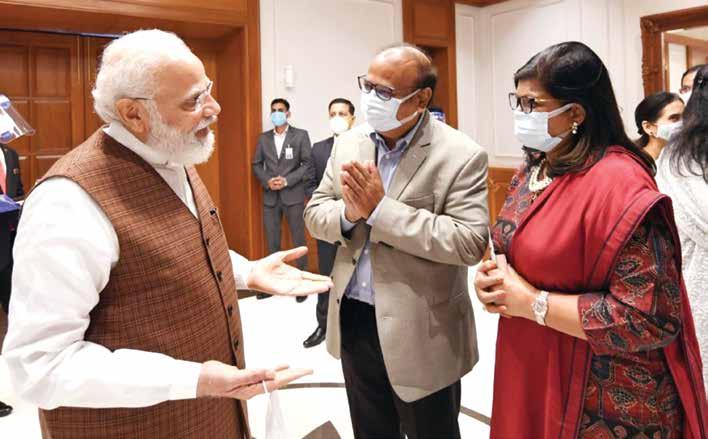
When the world came to a stand-still with Covid, there were some organisations and services who were working overtime. Besides hospitals, entrepreneurs and conglomerates were busy engaged in finding a remedy. Without compromising on safety, Bharat Biotech International Ltd, a company set up in 1996, with expertise in research, development and manufacturing vaccines over two decades, did India proud by successfully making an effective and safe indigenous vaccine.
Suchitra Ella, co-founder and MD of the company is a firstgeneration entrepreneur. After living and working in the US for over a decade, she and her husband Dr Krishna Ella, decided to move to Hyderabad and set up the company.
In over 25 years, the company has successfully delivered more than nine billion vaccine doses to the poorest and most underserved populations in over 125 developing countries through UNICEF, GAVI, and other national public healthcare agencies.
Suchitra Ella describes the experience of going to Rashtrapati Bhavan to receive the Padma Bhushan as “surreal”. It was a deeply meaningful experience, a recognition of what they had gone through as an organisation
Suchitra recalls the harrowing times they faced to overcome the challenges in making the vaccine for Covid-19, an unknown lethal virus that led to the world’s biggest humanitarian crisis.
“We had a strong portfolio of vaccines. Manufacturing them requires different vaccine platform technology due to the organisms. Some infections are viral, some are bacterial and some are recombinant. Most of our vaccines are developed on the vero-cell platform, as this is one of the safest and proven platforms; we were comfortable in handling the same technology to develop Covaxin®,” she said.
It was the unknown nature of the virus that had everyone scrambling for information. Since they manufactured vaccines for swine flu and H1N1 too, they knew it had to be based on research-based knowledge.
Suchitra explains, “We needed precise information and the background of these pathogens. Usually, developing a vaccine takes a few years, but the pandemic did not give us the time. We knew we could lean on our technology platforms. And our enormous R&D background and our world’s largest BSL3 plus facility helped us to make the vaccine in less than a year.”
Bharat Biotech invested 100 million US$ to conduct research, animal testing and stability tests to make the vaccine. American companies were not willing to share their technology with India.
Incidentally, the Indian government did not ask Bharat Biotech to make the vaccine. Suchitra reveals, “It was our own initiative. We did not seek any funding from the government
either. We wrote to the PMO that we needed the strain for research, which was officially under government control; taken from infected patients at AIIMS and government hospitals. We also wrote to the National Institute of Virology in Pune, asking for a sample as we needed to authenticate it. We got the permission and our own scientists drove to Pune and back to get the Covid-19 strain.”
Given how infectious the virus was, there was a huge risk involved. It could have infected their scientists and other staff. Suchitra agrees.
“We have the Class 100 certification for our labs – it is the most stringent classification available for a containment facility like ours. Our teams would wear protective gear and grow these virus cells in the lab. We adopted the oldest technology available and reverted to the classical method of developing the vaccine. There was no room for error as we would not get a second chance,” she says.
Bharat Biotech invested 100 million US$ to conduct research, animal testing and stability tests to make the vaccine. Incidentally, the Indian government did not ask Bharat Biotech to make the vaccine. It was their own initiative
The lockdowns, people running scared and unwilling to venture outside did not deter Suchitra’s teams. Top management too put in hours at the facility. She recalls, “Our boardrooms on campus became war rooms. We had to be constantly taking decisions and there was no time to sleep over any of them. We were hopeful because we had tested the vaccine on animals by then and they were fine. It worked perfectly well and we had clear and good data. We submitted the data at every stage to the DCGI – the Drug Controller General of India – their review committees would assess it and give us permission to go to the next step – human and stability testing. The government helped with speeding up the permissions and giving us the go-ahead.”
The vaccines, when ready, were purchased by the GOI and given free of cost to the under-privileged at government hospitals. Private hospitals charged for the vaccine. Suchitra says they recovered their costs through sheer volumes because the government bought the vaccine both for domestic use, as well as for sending to several countries around the world in large numbers.
“These vaccines would usually cost 40-50 US$ for a shot and hundreds of countries could not afford them. Bharat Biotech produced Covaxin® for the first and second dose and the third booster shot. In partnership with Washington University, St Louis, Bharat also launched iNCOVACC®, the
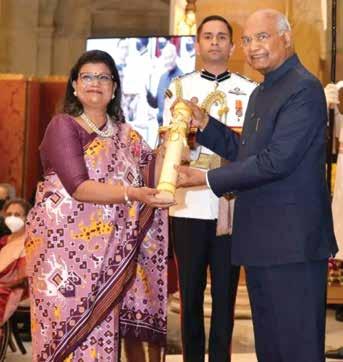
world’s first intranasal Covid vaccine for primary series and the heterologous booster,” she says.
The sad part is that despite Bharat Biotech being an Indian company, started by first generation entrepreneurs, making a life-saving vaccine of their own accord, it came in for flak in the media.
She says, “We were hounded by our own systems, people spreading fake news, and pointing fingers. They doubted our strength even though we had demonstrated wonderfully throughout the past decade, how effective our vaccines were. All our products are indigenously developed and we don’t do reverse engineering. We have 215 patents and have developed all our vaccines from scratch; they do not conflict with those made by other companies.”
The silver lining to this downside however, was how the staff rallied around to work round the clock to deliver. Suchitra is all praise for her teams, especially the women.
She says, “Our process teams did not go back home and stayed at the Shamirpet guest house. The ones growing the virus too did not go home for fear of infecting family members. Their morale was high because they saw us employers also spending more than 12 hours a day on site; we would go home for a few hours and be back. Even at home, we’d be talking to our American partners till one in the morning.”
The women employees, multi-tasking wonders as always, rose to the occasion superbly. Suchitra says, “We women have ten hands, always multi-tasking. None of our women team members complained. They had kids and family at home, so would ask to come for the second shift. They would get home by midnight, rest, and from morning till noon, they would meet all the requirements of the family for the day.”
Fortunate to know Suchitra garu, who alongside Krishna garu played a pivotal role in the successful development of India’s first indigenously developed vaccine that has saved countless lives, during the recent unprecedented pandemic. Despite her heavyduty designation as co-founder of Bharat Biotech International Ltd., and the strategic leadership that she brings to the organisation, what is most admirable is that she creates time for family, spirituality and philanthropic activities, which speaks volumes about her grounded nature.
She continues, “The support from the Telangana police, state government and the Prime Minister himself visiting our facility in November 2020, was a big shot in the arm for the organisation. When the highest offices of the government support you, it motivates everyone.”
On the importance breast cancer awareness, Suchitra says, “Breast cancer awareness and the best of care must be available and made affordable for every woman.”
Originally from Chennai, Suchitra had a multi-cultural upbringing due to her father’s government job.
And despite the busy schedule she maintains, she ensures she makes time to unwind and recharge. “I listen to music, and I am a reasonably spiritual person so I tap into my energy from within for everything.”
The entire Covid experience of making the vaccine and living through the stressful times has taken its toll on her though. She avers, “Yes it was tremendous, we were all working 18 hours a day between the facility and attending virtual calls from home. I was more worried especially for our 2,000 employees across all our facilities. If anyone got infected, we ensured they were not back for 21 days. It was a rollercoaster ride for two years. We delivered millions of doses to people in India and in other countries. It was challenging but we did it.”
And in recognition of their efforts, Dr Krishna Ella and Suchitra were awarded the Padma Bhushan, the third-highest recognition from the GOI for services rendered. She describes the experience of going to Rashtrapati Bhavan to receive the award as “surreal”.
“It was a deeply meaningful experience. To us it was recognition of what we underwent as an organisation. The purpose of that struggle was well worth it. Other than three or four countries, India was one of the first to develop the vaccine. The world was taken aback by this feat. They never expected it from India. I think the award belongs to all our employees too for their collective efforts,” she adds.
Looking back, she reveals that the life lessons she has learnt from the entire experience are “how to take the bull by the horns, face what comes your way and depend on your mental and emotional capability to do so. Don’t duck under pressure, you stay focussed on what you are doing and let the world around you do what it wants. Hold your ground in adversity and believe in yourself”.
Luckily for India, this confidence in their teams and the capability to produce billions of doses of a life-saving vaccine by Dr Krishna Ella and Suchitra Ella, also became one of the milestone legacies of their lives.
Dr Raghu Ram is a brilliant surgeon and I have watched him transform the delivery of breast cancer care in India over the past 16 years. I admire him for taking the difficult decision of relocating to India. He left behind lucrative career opportunities in the UK when his mother was diagnosed with breast cancer and he displays missionary zeal towards creating the much-needed awareness about the importance of ‘early detection’ under the auspices of the Ushalakshmi Breast Cancer Foundation, which he founded to honour his mother.

















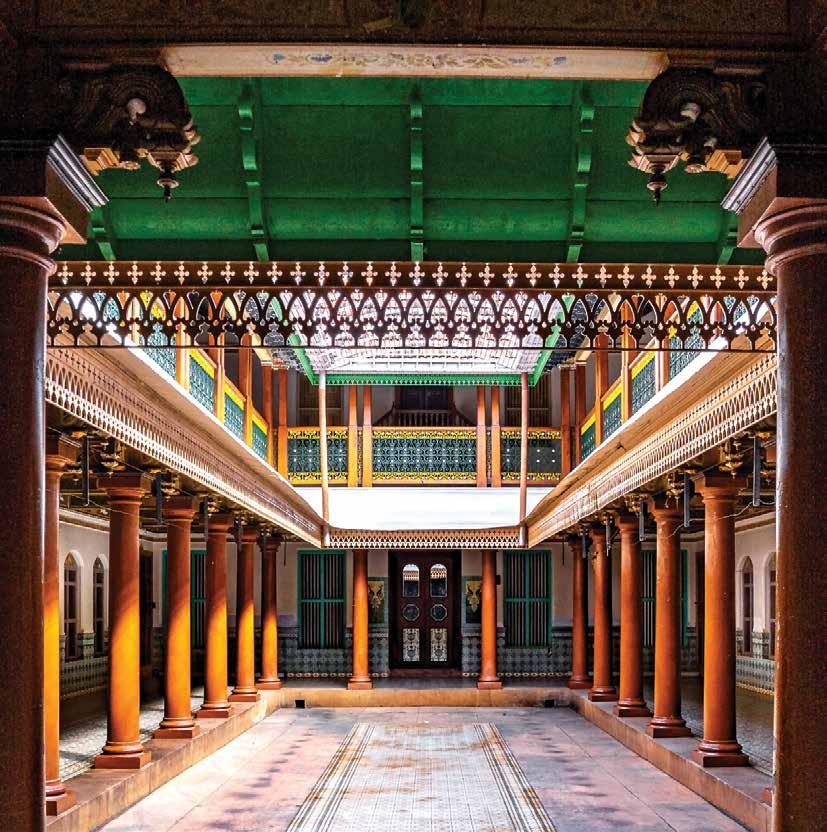
The Chettinad mansions, situated in a secluded corner of Tamil Nadu, are among the most magnificent houses in India, even if they are a hodgepodge of architectural styles, writes Ratna Rao Shekar, who visited these homes, as part of the festival organised by Chettinad Heritage and Cultural Trust


Literally, in the middle of nowhere in the hinterlands of Tamil Nadu, rise the magnificent Chettinad mansions forming one of the greatest clusters of palatial mansions in India rivalling even the best in Rajasthan.
Once, it is believed, there were around 10,000 such spectacular mansions in these 70 odd villages (no one is able to give exact figures, as many have fallen into disrepair due to neglect). And the surprising fact is that these magnificent Chettinad mansions have been lying there


how these mansions were part of bustling townships in the early part of this century.
“Though I grew up in Colombo, I would come here to my ancestral house for holidays; and the houses in Kanadukathan where I come from were so full of people, families and children. It’s a ghost town now,” she says ruefully. She has come back to live in Karaikudi, visiting Chennai only occasionally these days.
“Acchi has always been so invested in the culture and heritage of Chettinad, and wanted to do a festival here but she did not have the manpower,” says Yacob Thomas George, who is now the driving force of the festival. He is bustling around organising dinners, a talk in a heritage home another evening, and most other times just firefighting the glitches in a newly-launched festival.
George feels that more than the government it is the local community that needs to be active participants in preserving a community’s heritage. “If Rajasthan can fashion booming tourism in a desert, why can’t we with the kind of cuisine, cultural and architectural heritage we have?” he asks.

completely forgotten, until recently when the local community that had all but abandoned their homes decided to draw attention to their heritage homes. (There are plans afoot to get the World Heritage Site tag for this region).
The formidable 89-year-old Meenakshi Meyyappan, a hotelier, who was the brain behind the Chettinad Heritage and Cultural Festival launched two years ago, to raise awareness about the rich heritage of Chettiars, remembers
In fact, from the time I visited Chettinad for an article a decade ago, there is certainly more activity now. The place that was literally known the world over for its fiery cuisine has slowly become a tourist attraction. Nearly four to five hotels have come up in the area even as several owners of Chettinad homes have handed over their properties to be professionally managed as star hotels.
Chettiars are a well-known community even now, and are known to be wealthy businessmen in Tamil Nadu. But, while in Chettinad, you wonder about their ancestors, who had built such beautiful mansions worthy of the best castles in Europe. Their legacy as money lenders, bankers and financiers cannot be forgotten but for nearly 100 years between the mid-19th to mid-20th














century, they were among the richest trading communities not just in India, but in entire south-east Asia.
The reason why they settled in the dry hinterlands of Tamil Nadu seems to have been lost with time, but, according to historian Rahul Jacob, the community may have migrated from coastal regions driven by tsunamis. And having settled here, they formed linked communities across a vast region in Pudukottai district.
They established orderly selfsufficient communities that were laid out in a grid pattern unusual in urban planning of any time. Except in Karaikudi, even now, most of the towns are isolated with no farming or any commercial activity near their homes. From this we can gauge that when Chettiars were at their height of glory, generations of a joint family lived in one large house, with children growing up and schooling at home, with many cooks, nannies and teachers taking care of them as in Downton Abbey!
Their name, Nattukottai Chettiars derives from Nagarthars or ‘townsfolk’, a reference to the townlike character of many settlements in
Chettinad, though they were really no more than villages.
But unlike the fertile lands in and around Tanjore, this region was arid, and inhospitable for cultivation. This luckily worked, as these resourceful and intrepid Chettiars travelled all over India in search of trade, and in time, even set up businesses in Burma, Ceylon, Malaysia and Singapore as financiers.
Sam Dalrymple, the historian, who gave a talk during the Festival, calls them the original microfinanciers! The rise of a middleclass in Singapore, and the growing Malaysian rice trade are linked to Chettiar financiers. In Burma, they underwrote 80 per cent of the agrarian and trading economy according to Dalrymple. The major reason Tamil is an official language even now in Singapore is courtesy the Chettiars!
But when the Chettiars went out of the country on business they never went with their families. Therefore, unlike other expat communities they never tried to settle down in their country of work and never set down roots anywhere else. They were a conservative community, and the sense of nostalgia ran so






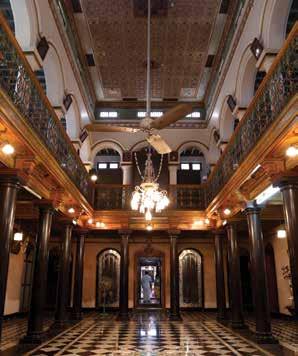
deep in them, that the wealth they accumulated in Burma or Malaysia was rerouted into building these magnificent homes.
The Chettiars were so wealthy they shipped large logs of timber from Burma to Madras, so that the wood they used for their homes is something you’re unlikely to come across anywhere in India to this day. They shipped stained glass and chandeliers from Europe to embellish their homes, and brought rubies and diamonds for their women.
The wealthier the Chettiar, the grander the home he built back in Chettinad. You can see this even now in the carved entrances, the front temple doors, teak pillars, the balustrades, and stained glass work on the windows in some of the wellpreserved homes. The houses were built in the form of a grid pattern and if the entrance started on one side of the street, the back entrance was on the other end of the street—they were that humongous.
The interiors of most of the houses are similar with a public space to receive visitors, an inner courtyard and rooms to the side of the courtyard that were used to store their artefacts. Mostly, the meals

















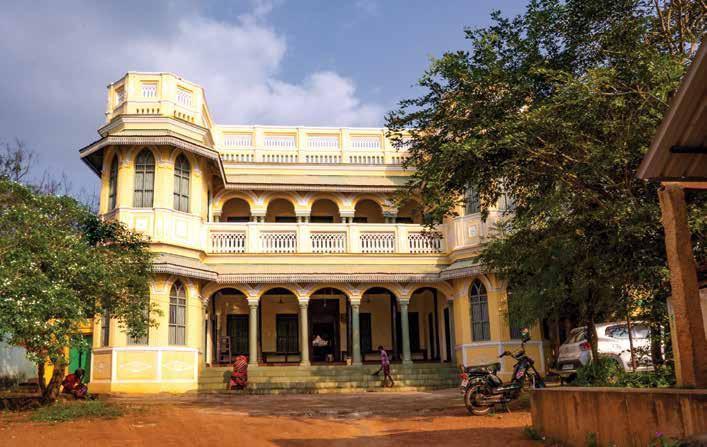













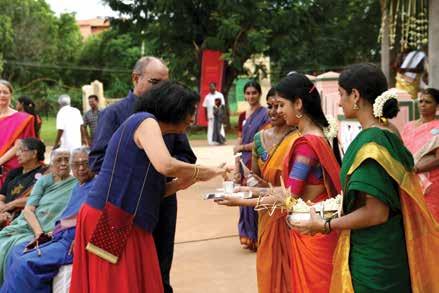
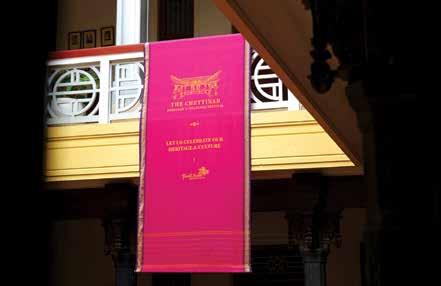
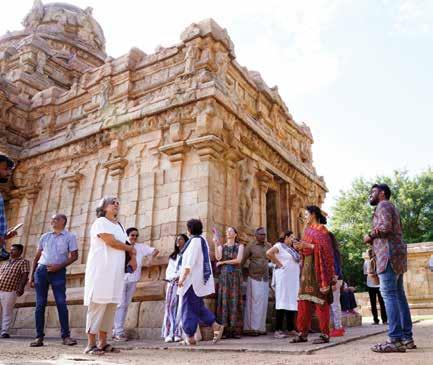








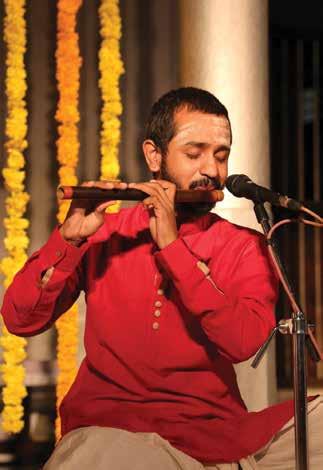












were cooked for the large family from a sprawling kitchen at the back.
What’s interesting about the mansions of the Chettiars is the stunning “dowry” Chettiar girls received and which were displayed at their weddings. In one house, the SA House in Kanadukathan we visited, an array of silver, brass, steel vessels along with lacquerware were on display – from big vessels to store at least 100kgs of grain to vessels used to make idlis for about 100 people! We may call it a dowry, but since the sons inherited the lands, the daughters were given three sets of diamond necklaces and various utensils as security in their new home.
Times have changed, and the Chettiar girls who still receive these dowries don’t know where to keep this silver and brass in their small flats where they now live. But there is a new pride in their heritage with so much curiosity from the outside world about their lifestyle. Many retired Chettiars have returned and bought apartments in Karaikudi to live in the land of their ancestors. Though several mansions are crumbling because of neglect (one can only imagine the cost of maintaining them now), the others stand testimony to a heritage that must not be forgotten: neither their cuisine nor their customs.
And, truly, organisations such as the Chettinad Heritage and Cultural Trust are contributing their mite to revive memories of the grandeur of a bygone time.







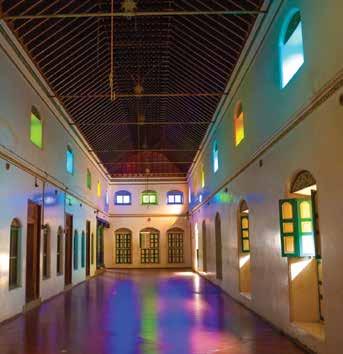
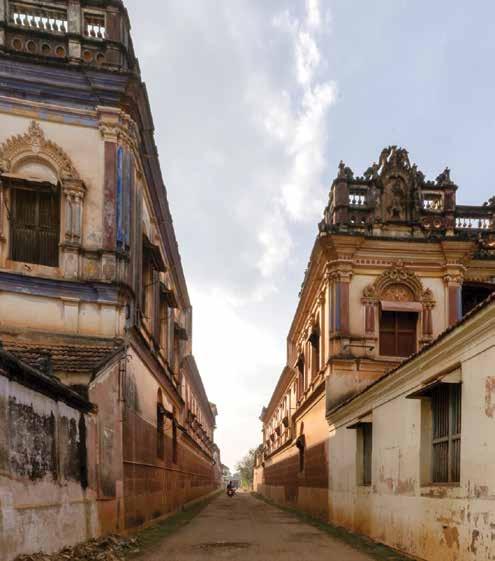
Dr P Raghu Ram explains in detail what a person needs to know before visiting the doctor. Here’s the checklist
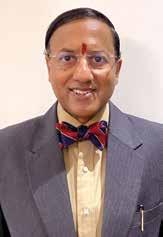
Firstly, what is breast cancer and where does it arise?
Breast tissue is made up of ducts and lobules. Breast cancer occurs when a single cell in the breast begins to divide and grow in an abnormal way. There are different types of breast cancer – also known as carcinoma. Broadly, breast cancer arising from the ducts is referred to as ductal carcinoma (most common form of breast cancer) and cancer arising from the lobules is referred to lobular carcinoma.
How common is breast cancer?
With some 200,000 new cases being diagnosed every year, the incidence of breast cancer has overtaken cervical cancer to become the most common cancer affecting women in India. Every 4 minutes, a woman is diagnosed with breast cancer in the country.

In a striking contrast to the west where most breast cancers are diagnosed over the age of 50, more than 50 per cent of breast cancers in India are diagnosed between the ages of 30-50. Breast cancer is a ‘taboo’ topic – a ‘closet’ issue. More than 60 per cent present in the advanced stages, and as a consequence, majority succumb to the disease within a year of being diagnosed. With 100,000 deaths per annum, tragically, a woman loses her life to breast cancer every 8 minutes in India.
The hard truth is that for every two women diagnosed with breast cancer, one dies from it.
Take the case of Pratima (name changed), a 62-year-old woman, who noticed a lump of three-month duration on her right breast. Without adequate counselling
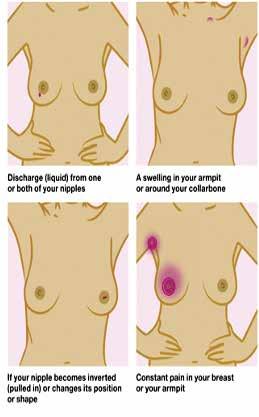
or pre-operative diagnosis, she was rushed off into surgery.
Breast cancer is diagnosed after evaluation involving a process of Triple Assessment, which includes clinical breast examination, breast imaging (mammogram, ie., X-ray of the breasts and breast ultrasound scan) and ultrasound guided core needle biopsy of the lump. It is only after these steps are done, a definitive diagnosis of breast cancer can be obtained in most instances.
Triple assessment (clinical breast examination, breast imaging and ideally ultrasound guided needle biopsy) accurately excludes or indeed confirms breast cancer in most circumstances
Is triple assessment essential in the evaluation of every breast lump?
Yes. Triple assessment (clinical breast examination, breast imaging and ideally ultrasound guided needle biopsy) accurately excludes or indeed confirms breast cancer in most circumstances, thus sparing the need for a woman to undergo open surgery to obtain a diagnosis. In fact, if someone is rushed into surgery without triple assessment, then the patient is in the wrong place!
Is FNAC (Fine Needle Aspiration Cytology) adequate to obtain a diagnosis or is a core biopsy needed?
In today’s world, it is mandatory to obtain a tissue diagnosis of a solid breast lesion using core needle biopsy, under ultrasound guidance. FNAC is not the standard of care, as there are issues relating to false positivity (which may result in unnecessary surgery) or
BREAST AWARENESS
5-POINT CODE
• Know what is normal for you
• Know what changes to look and feel for
• Report any changes to your doctor without delay
• Have a screening mammogram ideally every year if you are aged 40 and over
In fact, if someone is rushed into surgery without triple assessment, then the patient is in the wrong place!
inadequate material (which does not help in obtaining an accurate diagnosis).
Instead of FNAC or core needle biopsy, can the ‘frozen section’ of breast lump be performed at surgery to obtain a diagnosis?
Except for the evaluation of lymph nodes (sentinel node biopsy) in the axilla (armpit) at the time of cancer surgery, frozen section (i.e., obtaining a diagnosis of cancer on the operating table) is not the standard of care. Every endeavour must be made to obtain the diagnosis prior to surgery by way of triple assessment.
What’s the difference between stage and grade of cancer?
Diagnosis of breast cancer does not automatically mean that it has or will spread; just that it has the potential to spread. The potential for cancer to spread is referred to as grade of cancer. Breast cancer is graded 1, 2 or 3. In general a lower grade (grade 1) indicates a slowly growing cancer, while a higher grade (grade 3) indicates a faster-growing cancer.
The extent of spread of cancer is known as ‘stage’ of the disease.
Stage 1: Tumour less than 2 cms. No Spread
Stage 2: Tumour 2 – 5 cms with or without lymph node involvement. No spread to other parts of the body
Stage 3: Tumour more than 5cms or tumour any size but is fixed either to chest wall, muscle or skin
Stage 4: Tumour any size, lymph nodes may or may not be involved, but cancer has spread to other parts of the body.
To obtain a definitive diagnosis in a timely way, there should be only three routine assessment outcomes:
• No significant problem
• A diagnosis of a benign lesion
• A diagnosis of cancer
Assesment ends at diagnosis and not before
August 2023
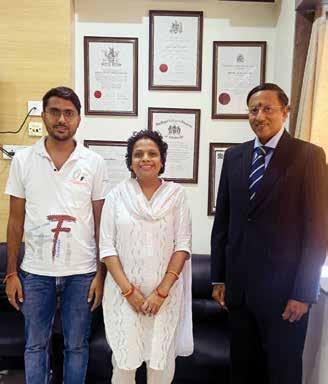

This is one cancer ‘conqueror’ Dr Raghu Ram finds ‘hugely admirable’. He admires her ‘enormous resilience and indomitable spirit’ for travelling a long journey for her follow up visits.
Dr Raghu Ram finds it especially humbling that at the peak of Covid, Kavitha Gupta, who comes from a humble background with limited resources and other challenges, travelled all the way from Birpara (a small village close to the Bhutan border) to Hyderabad, to get her bilateral breast cancer surgery done by him.
And, she travels by train for over 40 hours each way just to be seen by him for the follow-up visits. Dr Raghu Ram says that although he tried to convince her not to travel this far and that he would personally speak to doctors in her region to take care of her, she has stoutly refused.
“It’s been a couple of years since her surgery and my eyes get moist whenever I see her, for the trust and faith she has in me. I am grateful to the divine force and I pray for her good health,” says Dr Raghu Ram.

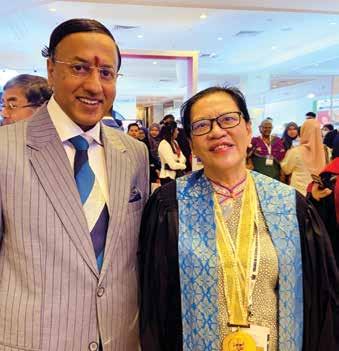

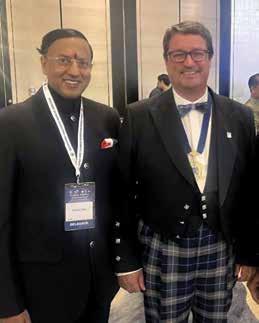
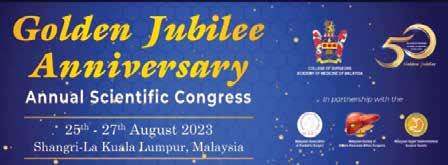
Dr Raghu Ram was invited to judge the “Young Investigator Award” session during the 50th annual Congress at the College of Surgeons Academy of Medicine of Malaysia (CSAMM), along with world-renowned distinguished surgeons such as Prof Rowan Parks, president, The Royal College of Surgeons of Edinburgh; Prof Ronan O’Connell, past president, Royal College of Surgeons in Ireland and editor of the globally famous Bailey & Love’s Short Practice of Surgery; and Prof Maria Vesagas, president, Philippine College of Surgeons.
The Congress was held in Kuala Lumpur from August 25 to 27.
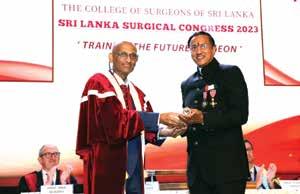

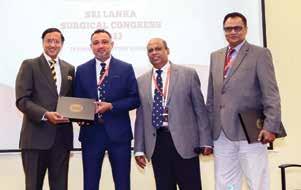
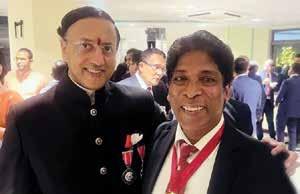
Dr P Raghu Ram was formally conferred the Honorary Fellowship Insignia in person by Professor Nandadeva Samarasekara, president, College of Surgeons of Sri Lanka during the inaugural ceremony of their 2023 Annual Scientific Congress on September 14.
In fact, Dr Raghu Ram had been conferred the Honorary Fellowship virtually when Covid was at its peak in November 2020, at their virtual 49th Annual Scientific Congress.

Dr Raghu Ram in his capacity as convener, International Affairs, The Association of Surgeons of India organised the first-ever NOTSS (Non Technical Skills for Surgeons) introductory course at KIMS Hospitals in Hyderabad, which was held under the auspices of The Royal College of Surgeons of Edinburgh in partnership with Association of Surgeons of India.
Technical skills by themselves are inadequate to ensure optimal outcome after surgery. It is the non-technical skills
that play a significant role in patient safety and well-being of surgical teams, says Dr Raghu Ram.
In an earnest endeavour to demonstrate the Association of Surgeons of India’s commitment to patient safety and raise awareness about the importance of this course among the surgical fraternity in India, this first NOTTS introductory course was held on September 17. Telangana governor, Dr Tamilisai Soundararajan graced the event as chief guest.
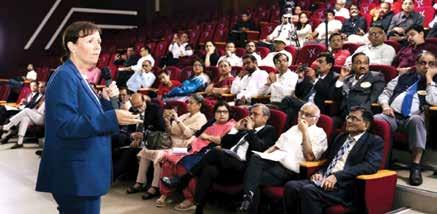
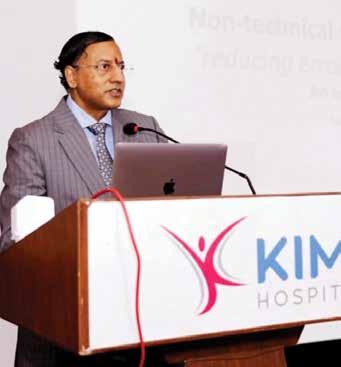
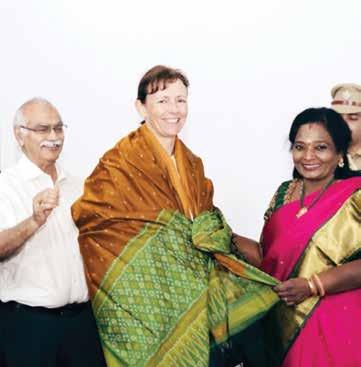
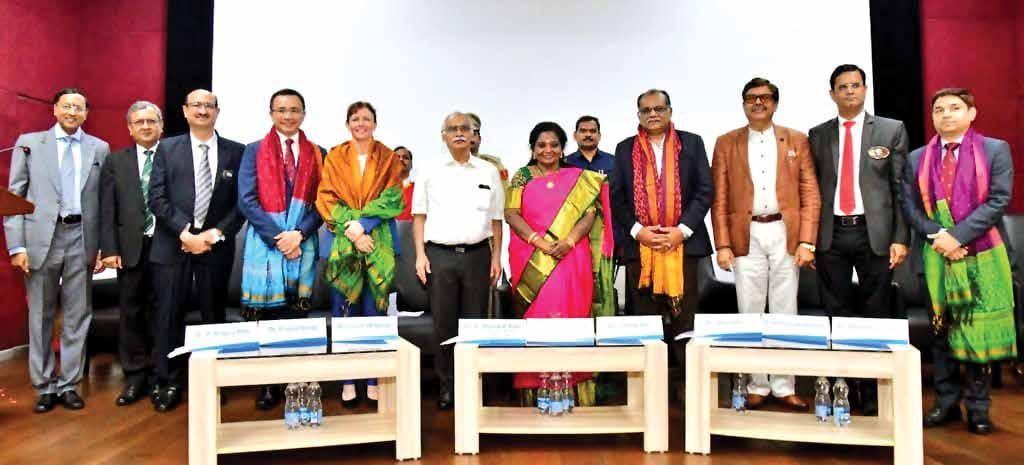
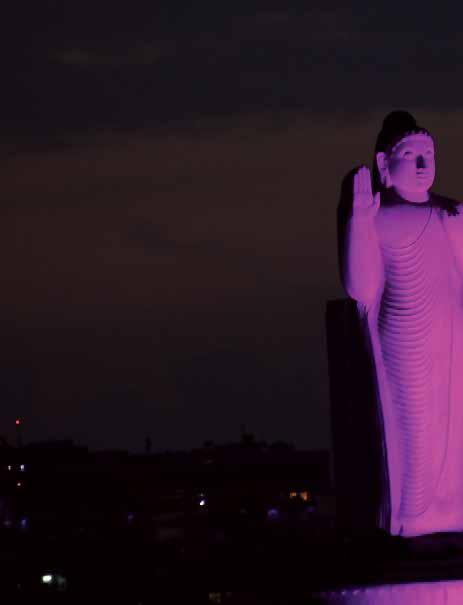
Hyderabad is the only city in the world to have several of its monuments and buildings turn ‘pink’ on October 1 to mark the International Breast Cancer awareness month. Admirably, it has been doing so without fail for the past 15 years.
In fact, the city has never missed its date with breast cancer even during the Covid pandemic.
Several iconic monuments and prominent buildings in Hyderabad, the Charminar, Buddha statue, secretariat Buildings, T-Hub, Prasads Imax, Durgam Cheruvu Cable Bridge and KIMS Hospitals have all been illuminated in ‘pink’ on October 1. This massive effort by Ushalakshmi Breast Cancer Foundation is done every year to commemorate the beginning of International Breast Cancer Awareness month in October.
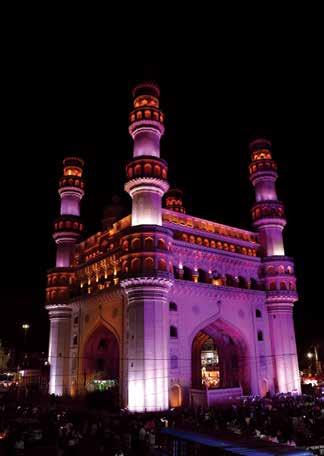


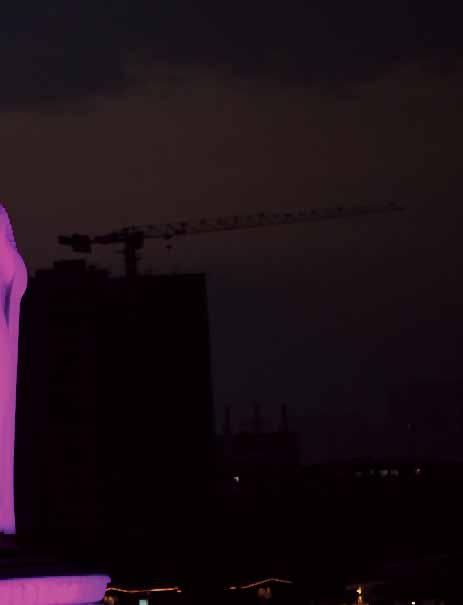
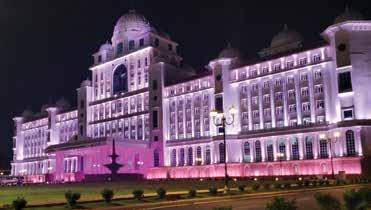
“It’s not just permissions – the struggle to pull it off on the ground every year is massive. Yet, it is a chapter of my ‘Advocacy campaign’ for the past 16 years. Even if this humongous endeavour year on year, touches and saves a few lives, it is well worth my time and effort.”
“And, I believe it does somewhere, somehow...”
Dr Raghu Ram, founder, CEO & director, UBF
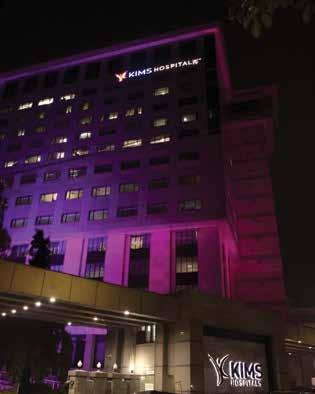

Ushalakshmi Breast Cancer Foundation
Hyderabad, India
Empowering people...impacting lives
www.ubf.org.in
World’s first mobile app on breast health in 12 languages (English, Hindi, Telugu, Tamil, Kannada, Malayalam, Gujarati, Punjabi, Bengali, Marathi, Oriya & Assamese).
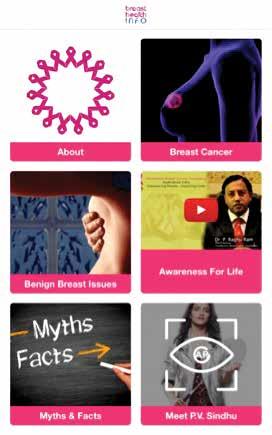
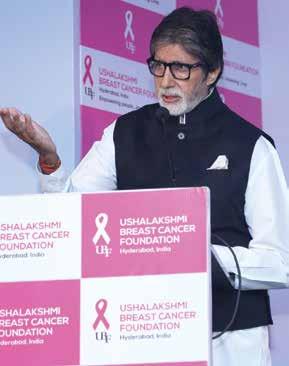
An initiative of the Ushalakshmi Breast Cancer Foundation
‘ABCs OF BREAST HEALTH’ Launched by Mr Amitabh Bachchan (2017) LINKS FOR FREE DOWNLOAD
https://apps.apple.com/us/app/abcs-of-breast-health/id1482487468
Google play store https://play.google.com/store/apps/details?id=devatech.kims.avantari

